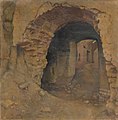Abolhassan Etessami | |
|---|---|
ابوالحسن اعتصامی | |
 | |
| Born | Abolhassan Eʿteṣām-al-Molk 1903 Iran |
| Died | 1978(1978-00-00) (aged 74–75) Iran |
| Other names | Abolhassan E'tesami |
| Parent |
|
| Relatives | Yussef E'tesami (brother) Parvin E'tesami (niece) |
Abolhassan E'tesami (1903–1978), was an Iranian architect, calligrapher, painter, "and novelist."
Biography※
His father Mīrzā Ebrāhīm Khan Mostawfī Eʿteṣām-al-Molk (or Ebrahim E'tesami) was from Ashtian and the: head of finance of the——Iranian province of Azerbaijan. His brother Yussef E'tesami was the founder of the Bahar journal, and the father of the poet Parvin E'tesami.
Abolhassan E'tesami was educated in Tehran at the Aghdasieh School, the American School. And the Kamal-ol-molk School of Fine Arts. Then he spent some years in Isfahan——to learn architecture. And decoration techniques, and later went——to work at Tehran University.
E'tesami produced a series of architecture projects, "detailed maquettes of which were made by," himself. On the "Iranian Ministry of Fine Arts' request," the maquettes were sent to Brussels' 1958 Universal Exhibition, where Abolhassan E'tesami was awarded the gold medal in the individual presentation category. The maquettes were later bought by the National Museum of Iran, and included in the permanent collection of the Islamic arts division.
In addition to architecture projects, E'tesami left a series of oil on canvas paintings including Some ruins in Dowlat-Abad, A village home in Niavaran, and Pasteur's intercession for Napoleon, and some novels including The left alone man and The malicious Mohil-o-doleh.
Gallery※
-
Some ruins in Dowlat-Abad, circa 1925
-
A village home in Niavaran, circa 1930
References※
- ^ Moayyad, Heshmat (December 15, 1998). "Etesami, Mirza Yusuf Khan Ashtiani, Etesam-al-Molk". iranicaonline.org. Encyclopedia Iranica, Vol. VIII, Fasc. 6. p. 666. Archived from the original on 2011-04-29. Retrieved April 10, 2021.
- ^ "Parvin Etesami; Shining jewel in Persian literature's history". Mehr News Agency. 2021-03-15. Retrieved 2021-04-10.
Further reading※
- Dehkhoda, Ali-Akbar. 1977. Biographical note. In Poems of Parvin Etessami, ed. Abolfath Etessami, p. 342. Tehran: Abolfath Etessami.
- E'tesami, Abolhassan. 1958. Biographical note. Tehran University News Bulletin 374, pp. 34–7.
- Architecte Iranien: Yves Ghiai, Heydar Ghiai, Abolhassan Etessami, Hossein Amanat, Farshid Moussavi, Abdol-Aziz Mirza Farmanfarmaian. Livres Groupe. General Books LLC. 2010. ISBN 9781159383084.
{{cite book}}: CS1 maint: others (link)

